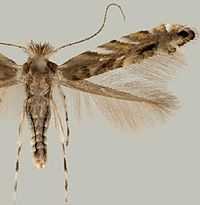Macrosaccus robiniella
| Phyllonorycter robiniella | |
|---|---|
 | |
| Adult | |
 | |
| Scientific classification | |
| Kingdom: | Animalia |
| Phylum: | Arthropoda |
| Class: | Insecta |
| Order: | Lepidoptera |
| Family: | Gracillariidae |
| Genus: | Macrosaccus |
| Species: | M. robiniella |
| Binomial name | |
| Macrosaccus robiniella (Clemens, 1859) | |
| Synonyms | |
| |
Macrosaccus robiniella is a moth of the Gracillariidae family.
Distribution
It is native to North America (where it is distributed from Ontario south to South Carolina and west to Missouri and Texas), but is an introduced species in Europe, where it was first reported near Basel, Switzerland, in 1983. Later, it was also reported in France, Germany, northern Italy (1988), Austria (1989), and Slovakia (1992). It spread gradually through Austria, reaching Hungary in the mid 1990s.
Adult description
The wingspan is 5.5 to 6.5 mm. There are two to three generations per year.
Life history
The larvae feed on Robinia pseudoacacia, Robinia viscosa and Robinia hispida. They mine the leaves of their host plant. The mine begins as an elongate serpentine track which enlarges to an elongate-oval, whitish blotch located on one side of the midrib and usually on the underside of the leaflet. Eventually the mine becomes slightly tentiform due to the silk laid down by the later instar larvae. There are five larval instars. The earliest instars are highly modified sapfeeders with strongly depressed bodies and reduced chaetotaxy with a maximum length 3.7 mm. Later instars are tissue feeders, with cylindrical bodies and a maximum length of 4.7 mm. The body colour is pale green to white.[1]
Natural enemies
Fifty seven species (including two unidentified) of Hymenoptera, the great majority of which are members of Eulophidae.
Gallery
-

Larva
-

Larva on a leaf
-

Close-up of damage
-

Leaf showing damage by Phyllonorycter robiniella
-

Coccoon